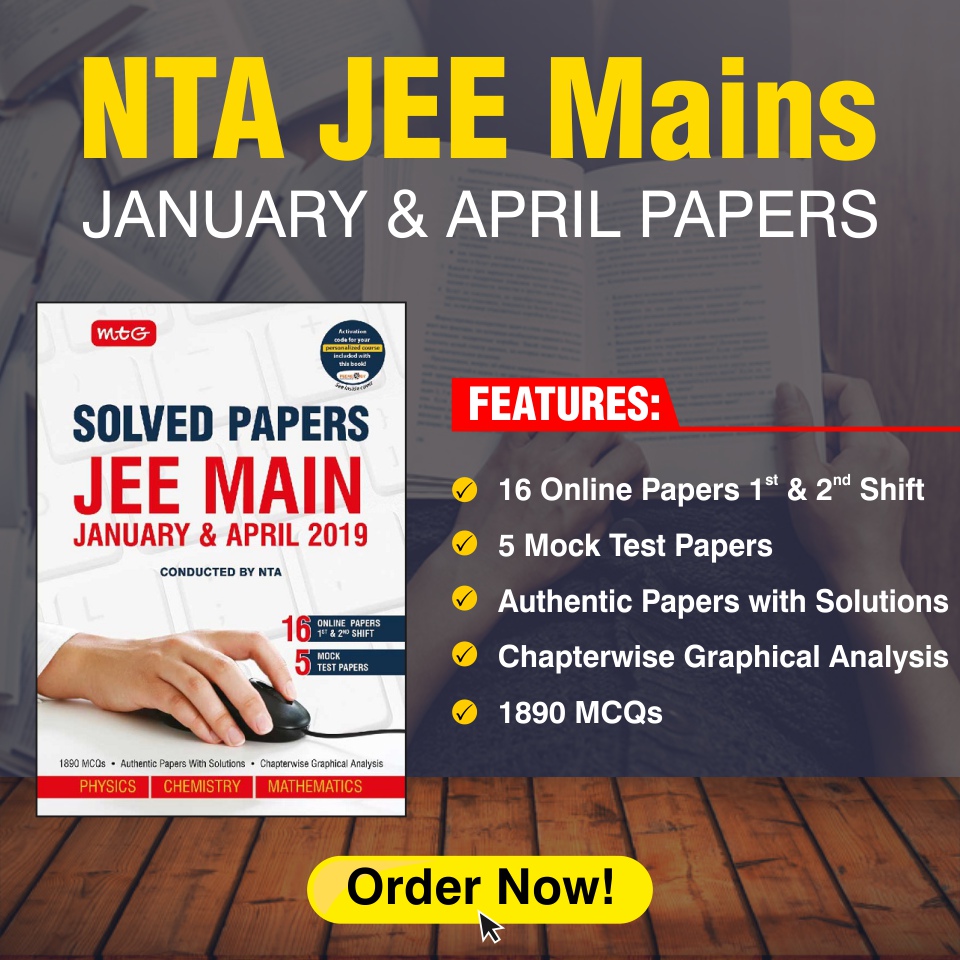The release of JEE Main 2020 registration form has increased the anxiety of all JEE Main 2020 aspirants. Students are in search of the procedure of application form filling, syllabus, best books for more and more practice, tips on how to utilise the remaining time more effectively so on so forth.
So, with the release of registration details NTA has release JEE Main 2020 syllabus also. It is more or less same as the previous year. Syllabus will have chapters of class XI and XII both in Physics, Chemistry and Mathematics. Though the syllabus is equivalent to the class XI and XII, the level of questions is considered high.
You may check the level of JEE Main questions in NTA conducted JEE Main Jan & Apr- 2019 (PCM)

Complete syllabus is also available on the official website of JEE Main. For your easy reference we are making it available here too. You may also find the link to download the complete syllabus in PDF form also.
Pattern JEE Main is slightly changed. This you may get here : JEE Main 2020 new exam pattern
JEE Main 2020 Syllabus : Physics
The syllabus contains two Sections – A and B. Section – A pertains to the Theory Part having 80% weightage, while Section – B contains Practical Component (Experimental Skills) having 20% weightage.
Section A
Unit – 1: Physics and Measurement
Physics, technology and society, S. I. units, fundamental and derived units, least count, accuracy and precision of measuring instruments, errors in measurement.
Dimensions of physical quantities, dimensional analysis and its applications.
Unit – 2: Kinematics
Frame of reference, motion in a straight line: position-time graph, speed and velocity, uniform and non-uniform motion, average speed and instantaneous velocity.
Uniformly accelerated motion, velocity-time, position-time graphs, relations for uniformly accelerated motion.
Scalars and vectors, vector addition and subtraction, zero vector, scalar and vector products, unit vector, resolution of a vector, relative velocity, motion in a plane, projectile motion, uniform circular motion.
Unit – 3: Laws of Motion
Force and inertia, Newton’s first law of motion, momentum, Newton’s second law of motion, impulse, Newton’s third law of motion, law of conservation of linear momentum and its applications, equilibrium of concurrent forces.
Static and kinetic friction, laws of friction, rolling friction.
Dynamics of uniform circular motion: centripetal force and its applications.
Unit – 4: Work, Energy and Power
Work done by a constant force and a variable force, kinetic and potential energies, work-energy theorem, power.
Potential energy of a spring, conservation of mechanical energy, conservative and non-conservative forces, elastic and inelastic collisions in one and two dimensions.
Unit – 5: Rotational Motion
Centre of mass of a two-particle system, centre of mass of a rigid body, basic concepts of rotational motion, moment of a force, torque, angular momentum, conservation of angular momentum and its applications, moment of inertia, radius of gyration, values of moments of inertia for simple geometrical objects, parallel and perpendicular axes theorems and their applications.
Rigid body rotation, equations of rotational motion.
Unit – 6: Gravitation
The universal law of gravitation.
Acceleration due to gravity and its variation with altitude and depth.
Kepler’s laws of planetary motion.
Gravitational potential energy, gravitational potential.
Escape velocity, orbital velocity of a satellite, geostationary satellites.
Unit – 7: Properties of Solids and Liquids
Elastic behaviour, stress-strain relationship, Hooke’s law, Young’s modulus, bulk modulus, modulus of rigidity.
Pressure due to a fluid column, Pascal’s law and its applications.
Viscosity, Stokes law, terminal velocity, streamline and turbulent flow, Reynolds number, Bernoulli’s principle and its applications.
Surface energy and surface tension, angle of contact, application of surface tension – drops, bubbles and capillary rise.
Heat, temperature, thermal expansion, specific heat capacity, calorimetry, change of state, latent heat.
Heat transfer-conduction, convection and radiation, Newton’s law of cooling.
Unit – 8: Thermodynamics
Thermal equilibrium, zeroth law of thermodynamics, concept of temperature, heat, work and internal energy, first law of thermodynamics.
Second law of thermodynamics, reversible and irreversible processes, Carnot engine and its efficiency.
Unit – 9: Kinetic Theory of Gases
Equation of state of a perfect gas, work done on compressing a gas.
Kinetic theory of gases – assumptions, concept of pressure, kinetic energy and temperature, rms speed of gas molecules, degrees of freedom, law of equipartition of energy, applications to specific heat capacities of gases, mean free path, Avogadro’s number.
Unit – 10: Oscillations and Waves
Periodic motion – period, frequency, displacement as a function of time, periodic functions, simple harmonic motion (S.H.M.) and its equation, phase, oscillations of a spring – restoring force and force constant, energy in S.H.M. – kinetic and potential energies, simple pendulum – derivation of expression for its time period, free, forced and damped oscillations, resonance.
Wave motion, longitudinal and transverse waves, speed of a wave, displacement relation for a progressive wave, principle of superposition of waves, reflection of waves, standing waves in strings and organ pipes, fundamental mode and harmonics, beats, Doppler effect in sound.
Unit – 11: Electrostatics
Electric charges, conservation of charge, Coulomb’s law-forces between two point charges, forces between multiple charges, superposition principle and continuous charge distribution.
Electric field, electric field due to a point charge, electric field lines, electric dipole, electric field due to a dipole, torque on a dipole in a uniform electric field.
Electric flux, Gauss’s law and its applications to find field due to infinitely long, uniformly charged straight wire, uniformly charged infinite plane sheet and uniformly charged thin spherical shell.
Electric potential and its calculation for a point charge, electric dipole and system of charges, equipotential surfaces, electrical potential energy of a system of two point charges in an electrostatic field.
Conductors and insulators, dielectrics and electric polarization, capacitor, combination of capacitors in series and in parallel, capacitance of a parallel plate capacitor with and without dielectric medium between the plates, energy stored in a capacitor.
Unit – 12: Current Electricity
Electric current, drift velocity, Ohm’s law, electrical resistance, resistances of different materials,
V–I characteristics of ohmic and non-ohmic conductors, electrical energy and power, electrical resistivity, colour code for resistors, series and parallel combinations of resistors, temperature dependence of resistance.
Electric cell and its internal resistance, potential difference and emf of a cell, combination of cells in series and in parallel.
Kirchhoff’s laws and their applications, Wheatstone bridge, metre bridge.
Potentiometer – principle and its applications.
Unit – 13: Magnetic Effects of Current and Magnetism
Biot – Savart law and its application to current carrying circular loop.
Ampere’s law and its applications to infinitely long current carrying straight wire and solenoid.
Force on a moving charge in uniform magnetic and electric fields, cyclotron.
Force on a current-carrying conductor in a uniform magnetic field, force between two parallel current-carrying conductors-definition of ampere, torque experienced by a current loop in uniform magnetic field, moving coil galvanometer, its current sensitivity and conversion to ammeter and voltmeter.
Current loop as a magnetic dipole and its magnetic dipole moment, bar magnet as an equivalent solenoid, magnetic field lines, earth’s magnetic field and magnetic elements, para-, dia- and ferro- magnetic substances .
Magnetic susceptibility and permeability, hysteresis, electromagnets and permanent magnets.
Unit – 14: Electromagnetic Induction and Alternating Currents
Electromagnetic induction, Faraday’s law, induced emf and current, Lenz’s law, Eddy currents, self and mutual inductance.
Alternating currents, peak and rms value of alternating current/ voltage, reactance and impedance, LCR series circuit, resonance, quality factor, power in AC circuits, wattless current.
AC generator and transformer.
Unit – 15: Electromagnetic Waves
Electromagnetic waves and their characteristics, transverse nature of electromagnetic waves, electromagnetic spectrum (radio waves, microwaves, infrared, visible, ultraviolet, X-rays, gamma rays). Applications of electromagnetic waves.
Unit – 16: Optics
Reflection and refraction of light at plane and spherical surfaces, mirror formula, total internal reflection and its applications, deviation and dispersion of light by a prism, lens formula, magnification, power of a lens, combination of thin lenses in contact, microscope and astronomical telescope (reflecting and refracting) and their magnifying powers.
Wave optics – wavefront and Huygens principle, laws of reflection and refraction using Huygens principle, interference, Young’s double slit experiment and expression for fringe width, coherent sources and sustained interference of light, diffraction due to a single slit, width of central maximum, resolving power of microscopes and astronomical telescopes, polarisation, plane polarized light, Brewster’s law, uses of plane polarized light and polaroids.
Unit – 17: Dual Nature of Matter and Radiation
Dual nature of radiation, photoelectric effect, Hertz and Lenard’s observations, Einstein’s photoelectric equation, particle nature of light.
Matter waves-wave nature of particle, de Broglie relation, Davisson-Germer experiment.
Unit – 18: Atoms and Nuclei
Alpha-particle scattering experiment, Rutherford’s model of atom, Bohr model, energy levels, hydrogen spectrum.
Composition and size of nucleus, atomic masses, isotopes, isobars, isotones, radioactivity-alpha, beta and gamma particles/rays and their properties, radioactive decay law, mass-energy relation, mass defect, binding energy per nucleon and its variation with mass number, nuclear fission and fusion.
Unit – 19: Electronic Devices
Semiconductors, semiconductor diode – I-V characteristics in forward and reverse bias, diode as a rectifier, I-V characteristics of LED, photodiode, solar cell, Zener diode, Zener diode as a voltage regulator, junction transistor, transistor action, characteristics of a transistor, transistor as an amplifier (common emitter configuration) and oscillator, logic gates (OR, AND, NOT, NAND and NOR), transistor as a switch.
Unit – 20: Communication Systems
Propagation of electromagnetic waves in the atmosphere, sky and space wave propagation, need for modulation, amplitude and frequency modulation, bandwidth of signals, bandwidth of transmission medium, basic elements of a communication system (Block Diagram only).
Note: JEE Main Exam 2020 Registration (Released)
Section b
Unit – 21 : Experimental Skills
- Familiarity with the basic approach and observations of the experiments and activities:
- Vernier callipers-its use to measure internal and external diameter and depth of a vessel.
- Screw gauge-its use to determine thickness/diameter of thin sheet/wire.
- Simple Pendulum-dissipation of energy by plotting a graph between square of amplitude and time,
- Metre Scale – mass of a given object by principle of moments.
- Young’s modulus of elasticity of the material of a metallic wire.
- Surface tension of water by capillary rise and effect of detergents.
- Co-efficient of Viscosity of a given viscous liquid by measuring terminal velocity of a given spherical body.
- Plotting a cooling curve for the relationship between the temperature of a hot body and time.
- Speed of sound in air at room temperature using a resonance tube.
- Specific heat capacity of a given (i) solid and (ii) liquid by method of mixtures.
- Resistivity of the material of a given wire using metre bridge.
- Resistance of a given wire using Ohm’s law.
- Potentiometer –
(i) Comparison of emf of two primary cells.
(ii) Determination of internal resistance of a cell.
- Resistance and figure of merit of a galvanometer by half deflection method.
- Focal length of:
(i) Convex mirror
(ii) Concave mirror and
(iii) Convex lens using parallax method.
- Plot of angle of deviation vs angle of incidence for a triangular prism.
- Refractive index of a glass slab using a travelling microscope.
- Characteristic curves of a p-n junction diode in forward and reverse bias.
- Characteristic curves of a Zener diode and finding reverse break down voltage.
- Characteristic curves of a transistor and finding current gain and voltage gain.
- Identification of Diode, LED, Transistor, IC, Resistor, Capacitor from mixed collection of such items.
- Using multimeter to:
(i) Identify base of a transistor
(ii) Distinguish between npn and pnp type transistor
(iii) See the unidirectional flow of current in case of a diode and an LED.
(iv) Check the correctness or otherwise of a given electronic component (diode, transistor or IC).
JEE Main 2020 Syllabus: Chemistry
Section – A (Physical Chemistry)
UNIT – 1: SOME BASIC CONCEPTS IN CHEMISTRY
Matter and its nature, Dalton’s atomic theory, concept of atom, molecule, element and compound, physical quantities and their measurements in chemistry, precision and accuracy, significant figures, S.I. units, dimensional analysis, Laws of chemical combination, atomic and molecular masses, mole concept, molar mass, percentage composition, empirical and molecular formulae, chemical equations and stoichiometry.
UNIT – 2: STATES OF MATTER
Classification of matter into solid, liquid and gaseous states.
Gaseous State – Measurable properties of gases, Gas laws – Boyle’s law, Charle’s law, Graham’s law of diffusion, Avogadro’s law, Dalton’s law of partial pressure, concept of absolute scale of temperature, Ideal gas equation, kinetic theory of gases (only postulates), concept of average, root mean square and most probable velocities, real gases, deviation from Ideal behaviour, compressibility factor, van der Waals equation.
Liquid State – Properties of liquids – vapour pressure, viscosity and surface tension and effect of temperature on them (qualitative treatment only).
Solid State – Classification of solids – molecular, ionic, covalent and metallic solids, amorphous and crystalline solids (elementary idea), Bragg’s Law and its applications, unit cell and lattices, packing in solids (fcc, bcc and hcp lattices), voids, calculations involving unit cell parameters, imperfection in solids, electrical, and magnetic properties.
UNIT – 3: ATOMIC STRUCTURE
Thomson and Rutherford atomic models and their limitations, nature of electromagnetic radiation, photoelectric effect, spectrum of hydrogen atom, Bohr model of hydrogen atom – its postulates, derivation of the relations for energy of the electron and radii of the different orbits, limitations of Bohr’s model, dual nature of matter, de-Broglie’s relationship, Heisenberg uncertainty principle, elementary ideas of quantum mechanics, quantum mechanical model of atom, its important features, concept of atomic orbitals as one electron wave functions, variation of Y and Y2 with r for 1s and 2s orbitals, various quantum numbers (principal, angular momentum and magnetic quantum numbers) and their significance, shapes of s, p and d – orbitals, electron spin and spin quantum number, rules for filling electrons in orbitals – Aufbau principle, Pauli’s exclusion principle and Hund’s rule, electronic configuration of elements, extra stability of half-filled and completely filled orbitals.
UNIT – 4: CHEMICAL BONDING AND MOLECULAR STRUCTURE
Kossel – Lewis approach to chemical bond formation, concept of ionic and covalent bonds.
Ionic Bonding – Formation of ionic bonds, factors affecting the formation of ionic bonds, calculation of lattice enthalpy.
Covalent Bonding – concept of electronegativity, Fajan’s rule, dipole moment, Valence Shell Electron Pair Repulsion (VSEPR) theory and shapes of simple molecules.
Quantum mechanical approach to covalent bonding – valence bond theory – its important features, concept of hybridization involving s, p and d orbitals, Resonance.
Molecular Orbital Theory – its important features, LCAOs, types of molecular orbitals (bonding, antibonding), sigma and pi-bonds, molecular orbital electronic configurations of homonuclear diatomic molecules, concept of bond order, bond length and bond energy.
Elementary idea of metallic bonding, hydrogen bonding and its applications.
UNIT – 5: CHEMICAL THERMODYNAMICS
Fundamentals of thermodynamics: system and surroundings, extensive and intensive properties, state functions, types of processes.
First law of thermodynamics – Concept of work, heat internal energy and enthalpy, heat capacity, molar heat capacity, Hess’s law of constant heat summation, enthalpies of bond dissociation, combustion, formation, atomization, sublimation, phase transition, hydration, ionization and solution.
Second law of thermodynamics – Spontaneity of processes, DS of the universe and DG of the system as criteria for spontaneity, DG° (standard Gibbs energy change) and equilibrium constant.
UNIT – 6: SOLUTIONS
Different methods for expressing concentration of solution – molality, molarity, mole fraction, percentage (by volume and mass both), vapour pressure of solutions and Raoult’s law – Ideal and non-ideal solutions, vapour pressure – composition plots for ideal and non-ideal solutions, colligative properties of dilute solutions – relative lowering of vapour pressure, depression of freezing point, elevation of boiling point and osmotic pressure, determination of molecular mass using colligative properties, abnormal value of molar mass, van’t Hoff factor and its significance.
UNIT – 7: EQUILIBRIUM
Meaning of equilibrium, concept of dynamic equilibrium.
Equilibria involving physical processes – Solid – liquid, liquid – gas and solid – gas equilibria, Henry’s law, general characteristics of equilibrium involving physical processes.
Equilibria involving chemical processes – Law of chemical equilibrium, equilibrium constants
(Kp and Kc) and their significance, significance of DG and DG° in chemical equilibria, factors affecting equilibrium concentration, pressure, temperature, effect of catalyst, Le Chatelier’s principle.
Ionic equilibrium – Weak and strong electrolytes, ionization of electrolytes, various concepts of acids and bases (Arrhenius, Bronsted – Lowry and Lewis) and their ionization, acid – base equilibria (including multistage ionization) and ionization constants, ionization of water, pH scale, common ion effect, hydrolysis of salts and pH of their solutions, solubility of sparingly soluble salts and solubility products, buffer solutions. .
UNIT – 8 : REDOX REACTIONS AND ELECTROCHEMISTRY
Electronic concepts of oxidation and reduction, redox reactions, oxidation number, rules for assigning oxidation number, balancing of redox reactions.
Electrolytic and metallic conduction, conductance in electrolytic solutions, molar conductivities and their variation with concentration: Kohlrausch’s law and its applications.
Electrochemical cells – electrolytic and galvanic cells, different types of electrodes, electrode potentials including standard electrode potential, half – cell and cell reactions, emf of a galvanic cell and its measurement, Nernst equation and its applications, relationship between cell potential and Gibbs’ energy change, dry cell and lead accumulator, fuel cells.
UNIT – 9 : CHEMICAL KINETICS
Rate of a chemical reaction, factors affecting the rate of reactions concentration, temperature, pressure and catalyst, elementary and complex reactions, order and molecularity of reactions, rate law, rate constant and its units, differential and integral forms of zero and first order reactions, their characteristics and half – lives, effect of temperature on rate of reactions – Arrhenius theory, activation energy and its calculation, collision theory of bimolecular gaseous reactions (no derivation).
UNIT – 10 : SURFACE CHEMISTRY
Adsorption – Physisorption and chemisorption and their characteristics, factors affecting adsorption of gases on solids, Freundlich and Langmuir adsorption isotherms, adsorption from solutions.
Catalysis – Homogeneous and heterogeneous, activity and selectivity of solid catalysts, enzyme catalysis and its mechanism.
Colloidal state – distinction among true solutions, colloids and suspensions, classification of colloids – lyophilic, lyophobic, multi molecular, macromolecular and associated colloids (micelles), preparation and properties of colloids – Tyndall effect, Brownian movement, electrophoresis, dialysis, coagulation and flocculation, emulsions and their characteristics.
Section – B (Inorganic Chemistry)
UNIT – 11: CLASSIFICATION OF ELEMENTS AND PERIODICITY IN PROPERTIES
Modern periodic law and present form of the periodic table, s, p, d and f block elements, periodic trends in properties of elementsatomic and ionic radii, ionization enthalpy, electron gain enthalpy, valence, oxidation states and chemical reactivity.
UNIT – 12: GENERAL PRINCIPLES AND PROCESSES OF ISOLATION OF METALS
Modes of occurrence of elements in nature, minerals, ores, steps involved in the extraction of metals – concentration, reduction (chemical and electrolytic methods) and refining with special reference to the extraction of Al, Cu, Zn and Fe, thermodynamic and electrochemical principles involved in the extraction of metals.
UNIT – 13: HYDROGEN
Position of hydrogen in periodic table, isotopes, preparation, properties and uses of hydrogen, physical and chemical properties of water and heavy water, structure, preparation, reactions and uses of hydrogen peroxide, classification of hydrides – ionic, covalent and interstitial, hydrogen as a fuel.
UNIT – 14: s – BLOCK ELEMENTS (ALKALI AND ALKALINE EARTH METALS)
Group – 1 and 2 Elements
General introduction, electronic configuration and general trends in physical and chemical properties of elements, anomalous properties of the first element of each group, diagonal relationships.
Preparation and properties of some important compounds – sodium carbonate, sodium hydroxide and sodium hydrogen carbonate, Industrial uses of lime, limestone, Plaster of Paris and cement, Biological significance of Na, K, Mg and Ca.
UNIT – 15: p – BLOCK ELEMENTS Group – 13 to Group 18 Elements
General Introduction – Electronic configuration and general trends in physical and chemical properties of elements across the periods and down the groups, unique behaviour of the first element in each group.
Groupwise study of the p-block elements
Group – 13
Preparation, properties and uses of boron and aluminium, structure, properties and uses of borax, boric acid, diborane, boron trifluoride, aluminium chloride and alums.
Group – 14
Tendency for catenation, structure, properties and uses of allotropes and oxides of carbon, silicon tetrachloride, silicates, zeolites and silicones.
Group – 15
Properties and uses of nitrogen and phosphorus, allotropic forms of phosphorus, preparation, properties, structure and uses of ammonia, nitric acid, phosphine and phosphorus halides, (PCl3, PCl5), structures of oxides and oxoacids of nitrogen and phosphorus.
Group – 16
Preparation, properties, structures and uses of ozone, allotropic forms of sulphur, preparation, properties, structures and uses of sulphuric acid (including its industrial preparation), Structures of oxoacids of sulphur.
Group – 17
Preparation, properties and uses of hydrochloric acid, trends in the acidic nature of hydrogen halides, structures of interhalogen compounds and oxides and oxoacids of halogens.
Group – 18
Occurrence and uses of noble gases, structures of fluorides and oxides of xenon.
UNIT – 16: d – and f – BLOCK ELEMENTS
Transition Elements
General introduction, electronic configuration, occurrence and characteristics, general trends in properties of the first row transition elements – physical properties, ionization enthalpy, oxidation states, atomic radii, colour, catalytic behaviour, magnetic properties, complex formation, interstitial compounds, alloy formation, preparation, properties and uses of K2Cr2O7 and KMnO4.
Inner Transition Elements
Lanthanoids – Electronic configuration, oxidation states and lanthanoid contraction.
Actinoids – Electronic configuration and oxidation states.
UNIT – 17: COORDINATION COMPOUNDS
Introduction to coordination compounds, Werner’s theory, ligands, coordination number, denticity, chelation, IUPAC nomenclature of mononuclear coordination compounds, isomerism, bonding valence bond approach and basic ideas of crystal field theory, colour and magnetic properties, importance of coordination compounds (in qualitative analysis, extraction of metals and in biological systems).
UNIT – 18: ENVIRONMENTAL CHEMISTRY
Environmental Pollution – Atmospheric, water and soil. Atmospheric pollution – tropospheric and stratospheric.
Tropospheric pollutants – Gaseous pollutants: oxides of carbon, nitrogen and sulphur, hydrocarbons, their sources, harmful effects and prevention, green house effect and global warming, acid rain.
Particulate pollutants – Smoke, dust, smog, fumes, mist, their sources, harmful effects and prevention.
Stratospheric pollution – Formation and breakdown of ozone, depletion of ozone layer – its mechanism and effects.
Water Pollution – Major pollutants such as, pathogens, organic wastes and chemical pollutants, their harmful effects and prevention.
Soil Pollution – Major pollutants such as pesticides (insecticides, herbicides and fungicides), their harmful effects and prevention.
Strategies to control environmental pollution.
SECTION – C (Organic Chemistry)
UNIT – 19: PURIFICATION AND CHARACTERISATION OF ORGANIC COMPOUNDS
Purification – Crystallization, sublimation, distillation, differential extraction and chromatography – principles and their applications.
Qualitative analysis – Detection of nitrogen, sulphur, phosphorus and halogens.
Quantitative analysis (Basic principles only) – Estimation of carbon, hydrogen, nitrogen, halogens, sulphur, phosphorus.
Calculations of empirical formulae and molecular formulae, numerical problems in organic quantitative analysis.
UNIT – 20: SOME BASIC PRINCIPLES OF ORGANIC CHEMISTRY
Tetravalency of carbon, shapes of simple molecules – hybridization (s and p), classification of organic compounds based on functional groups: and those containing halogens, oxygen, nitrogen and sulphur, homologous series, Isomerism – structural and stereoisomerism.
Nomenclature (trivial and IUPAC)
Covalent bond fission – Homolytic and heterolytic: free radicals, carbocations and carbanions, stability of carbocations and free radicals, electrophiles and nucleophiles.
Electronic displacement in a covalent bond – Inductive effect, electromeric effect, resonance and hyperconjugation.
Common types of organic reactions – Substitution, addition, elimination and rearrangement.
UNIT – 21: HYDROCARBONS
Classification, isomerism, IUPAC nomenclature, general methods of preparation, properties and reactions.
Alkanes – Conformations: Sawhorse and Newman projections (of ethane), mechanism of halogenation of alkanes.
Alkenes – Geometrical isomerism, mechanism of electrophilic addition: addition of hydrogen, halogens, water, hydrogen halides (Markownikoff’s and peroxide effect), ozonolysis and polymerization.
Alkynes – Acidic character, addition of hydrogen, halogens, water and hydrogen halides, polymerization. Aromatic hydrocarbons – Nomenclature, benzene – structure and aromaticity, mechanism of electrophilic substitution: halogenation, nitration, Friedel – Craft’s alkylation and acylation, directive influence of functional group in mono-substituted benzene.
UNIT – 22: ORGANIC COMPOUNDS CONTAINING HALOGENS
General methods of preparation, properties and reactions, nature of C-X bond, mechanisms of substitution reactions. Uses/environmental effects of chloroform, iodoform, freons and DDT.
UNIT – 23: ORGANIC COMPOUNDS CONTAINING OXYGEN
General methods of preparation, properties, reactions and uses.
alcohols, phenols and ethers
Alcohols – Identification of primary, secondary and tertiary alcohols, mechanism of dehydration.
Phenols – Acidic nature, electrophilic substitution reactions: halogenation, nitration and sulphonation, Reimer – Tiemann reaction.
Ethers – Structure.
Aldehydes, ketones and carboxylic acids
Aldehydes and Ketones – Nature of carbonyl group, nucleophilic addition to >CO group, relative reactivities of aldehydes and ketones, important reactions such as – nucleophilic addition reactions (addition of HCN, NH3 and its derivatives), Grignard reagent, oxidation, reduction (Wolff Kishner and Clemmensen), acidity of
a-hydrogen, aldol condensation, Cannizzaro reaction, haloform reaction, chemical tests to distinguish between aldehydes and ketones.
Carboxylic acids – Acidic strength and factors affecting it.
UNIT – 24: ORGANIC COMPOUNDS CONTAINING NITROGEN
General methods of preparation, properties, reactions and uses.
Amines – Nomenclature, classification, structure basic character and identification of primary, secondary and tertiary amines and their basic character.
Diazonium Salts – Importance in synthetic organic chemistry.
UNIT – 25: POLYMERS
General introduction and classification of polymers, general methods of polymerization – addition and condensation, copolymerization, natural and synthetic rubber and vulcanization, some important polymers with emphasis on their monomers and uses – polythene, nylon, polyester and bakelite.
UNIT – 26: BIOMOLECULES
General introduction and importance of biomolecules.
Carbohydrates – Classification: aldoses and ketoses, monosaccharides (glucose and fructose), constituent monosaccharides of oligosaccharides (sucrose, lactose, maltose).
Proteins – Elementary Idea of a – amino acids, peptide bond, polypeptides, proteins – primary, secondary, tertiary and quaternary structure (qualitative idea only), denaturation of proteins, enzymes.
Vitamins – Classification and functions.
Nucleic acids – Chemical constitution of DNA and RNA, biological functions of nucleic acids.
UNIT – 27: CHEMISTRY IN EVERYDAY LIFE
Chemicals in medicines – Analgesics, tranquilizers, antiseptics, disinfectants, antimicrobials, antifertility drugs, antibiotics, antacids, antihistamins – their meaning and common examples.
Chemicals in food – Preservatives, artificial sweetening agents – common examples.
Cleansing agents – Soaps and detergents, cleansing action.
UNIT – 28: PRINCIPLES RELATED TO PRACTICAL CHEMISTRY
Detection of extra elements (N, S, halogens) in organic compounds, detection of the following functional groups: hydroxyl (alcoholic and phenolic), carbonyl (aldehyde and ketone), carboxyl and amino groups in organic compounds.
Chemistry involved in the preparation of the following:
Inorganic compounds – Mohr’s salt, potash alum.
Organic compounds – Acetanilide, p-nitroacetanilide, aniline yellow, iodoform.
Chemistry involved in the titrimetric exercises – Acids, bases and the use of indicators, oxalic acid vs KMnO4, Mohr’s salt vs KMnO4.
Chemical principles involved in the qualitative salt analysis:
Cations – Pb2+, Cu2+, AI3+, Fe3+, Zn2+, Ni2+, Ca2+, Ba2+, Mg2+, NH4+.
Anions – CO32–, S2–, SO42–, NO2–, NO3–, CI–, Br–, I– (insoluble salts excluded).
Chemical principles involved in the following experiments:
- Enthalpy of solution of CuSO4
- Enthalpy of neutralization of strong acid and strong base.
- Preparation of lyophilic and lyophobic sols.
- Kinetic study of reaction of iodide ion with hydrogen peroxide at room temperature.
JEE Main 2020 Syllabus : Mathematics
UNIT – 1 : SETS, RELATIONS AND FUNCTIONS
Sets and their representation, union, intersection and complement of sets and their algebraic properties, power set, relations, types of relations, equivalence relations, functions, one-one, into and onto functions, composition of functions.
UNIT – 2 : COMPLEX NUMBERS AND QUADRATIC EQUATIONS
Complex numbers as ordered pairs of reals, representation of complex numbers in the form a + ib and their representation in a plane, Argand diagram, algebra of complex numbers, modulus and argument (or amplitude) of a complex number, square root of a complex number, triangle inequality, quadratic equations in real and complex number system and their solutions, relation between roots and coefficients, nature of roots, formation of quadratic equations with given roots.
UNIT – 3 : MATRICES AND DETERMINANTS
Matrices, algebra of matrices, types of matrices, determinants and matrices of order two and three. Properties of determinants, evaluation of determinants, area of triangles using determinants. Adjoint and evaluation of inverse of a square matrix using determinants and elementary transformations, Test of consistency and solution of simultaneous linear equations in two or three variables using determinants and matrices.
UNIT – 4 : PERMUTATIONS AND COMBINATIONS
Fundamental principle of counting, permutation as an arrangement and combination as selection, Meaning of P (n,r) and C (n,r), simple applications.
UNIT – 5 : MATHEMATICAL INDUCTION
Principle of Mathematical Induction and its simple applications.
UNIT – 6 : BINOMIAL THEOREM AND ITS SIMPLE APPLICATIONS
Binomial theorem for a positive integral index, general term and middle term, properties of Binomial coefficients and simple applications.
UNIT – 7 : SEQUENCES AND SERIES
Arithmetic and Geometric progressions, insertion of arithmetic, geometric means between two given numbers. Relation between A.M. and G.M. Sum upto n terms of special series: ![]() . Arithmetic – Geometric progression.
. Arithmetic – Geometric progression.
UNIT – 8 : LIMITS, CONTINUITY AND DIFFERENTIABILITY
Real – valued functions, algebra of functions, polynomials, rational, trigonometric, logarithmic and exponential functions, inverse functions. Graphs of simple functions. Limits, continuity and differentiability. Differentiation of the sum, difference, product and quotient of two functions. Differentiation of trigonometric, inverse trigonometric, logarithmic, exponential, composite and implicit functions, derivatives of order upto two. Rolle’s and Lagrange’s Mean value theorems. Applications of derivatives: Rate of change of quantities, monotonic – increasing and decreasing functions, Maxima and minima of functions of one variable, tangents and normals.
UNIT – 9 : INTEGRAL CALCULUS
Integral as an anti – derivative. Fundamental integrals involving algebraic, trigonometric, exponential and logarithmic functions. Integration by substitution, by parts and by partial fractions. Integration using trigonometric identities.
Evaluation of simple integrals of the type
Integral as limit of a sum. Fundamental theorem of calculus. Properties of definite integrals. Evaluation of definite integrals, determining areas of the regions bounded by simple curves in standard form.
UNIT – 10: DIFFERENTIAL EQUATIONS
Ordinary differential equations, their order and degree. Formation of differential equations. Solution of differential equations by the method of separation of variables, solution of homogeneous and linear differential equations of the type:
UNIT – 11: COORDINATE GEOMETRY
Cartesian system of rectangular coordinates in a plane, distance formula, section formula, locus and its equation, translation of axes, slope of a line, parallel and perpendicular lines, intercepts of a line on the coordinate axes.
Straight lines – Various forms of equations of a line, intersection of lines, angles between two lines, conditions for concurrence of three lines, distance of a point from a line, equations of internal and external bisectors of angles between two lines, coordinates of centroid, orthocentre and circumcentre of a triangle, equation of family of lines passing through the point of intersection of two lines.
Circles, conic sections – Standard form of equation of a circle, general form of the equation of a circle, its radius and centre, equation of a circle when the end points of a diameter are given, points of intersection of a line and a circle with the centre at the origin and condition for a line to be tangent to a circle, equation of the tangent.
Sections of cones, equations of conic sections (parabola, ellipse and hyperbola) in standard forms, condition for y = mx + c to be a tangent and point(s) of tangency.
UNIT – 12: THREE DIMENSIONAL GEOMETRY
Coordinates of a point in space, distance between two points, section formula, direction ratios and direction cosines, angle between two intersecting lines. Skew lines, the shortest distance between them and its equation. Equations of a line and a plane in different forms, intersection of a line and a plane, coplanar lines.
UNIT – 13: VECTOR ALGEBRA
Vectors and scalars, addition of vectors, components of a vector in two dimensions and three dimensional space, scalar and vector products, scalar and vector triple product.
UNIT – 14: STATISTICS AND PROBABILITY
Measures of Dispersion – Calculation of mean, median, mode of grouped and ungrouped data. Calculation of standard deviation, variance and mean deviation for grouped and ungrouped data.
Probability – Probability of an event, addition and multiplication theorems of probability, Baye’s theorem, probability distribution of a random variate, Bernoulli trials and Binomial distribution.
UNIT – 15: TRIGONOMETRY
Trigonometrical identities and equations. Trigonometrical functions. Inverse trigonometrical functions and their properties. Heights and Distances.
UNIT – 16: MATHEMATICAL REASONING
Statements, logical operations and, or, implies, implied by, if and only if. Understanding of tautology, contradiction, converse and contrapositive.
Download JEE Main 2020 Syllabus in PDF






























